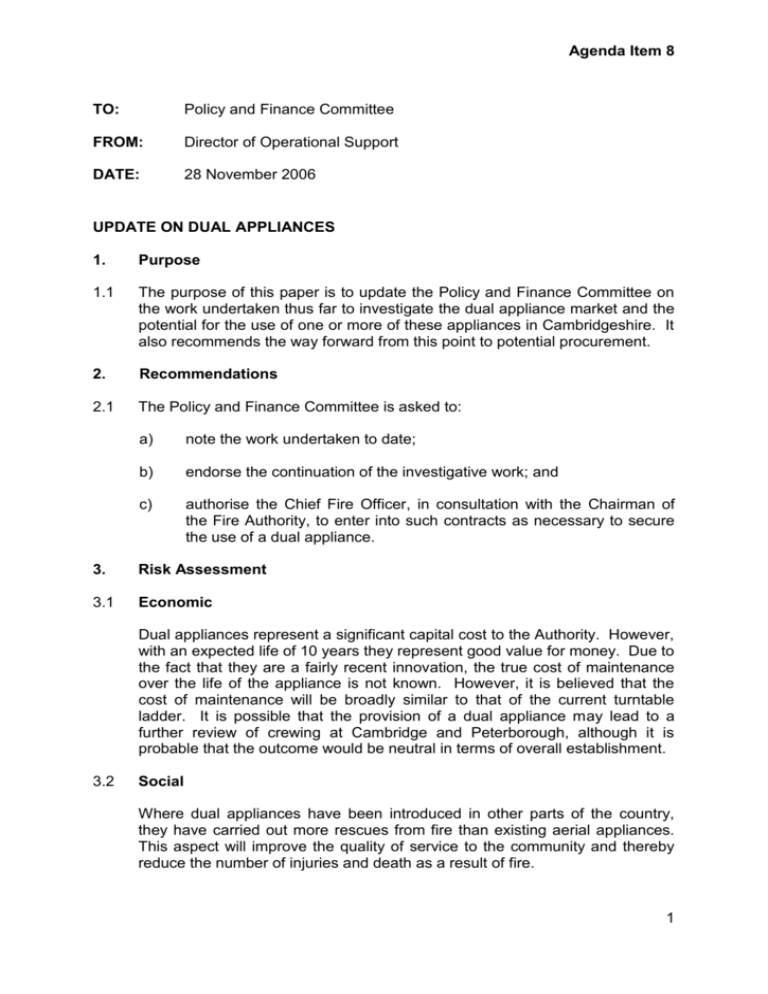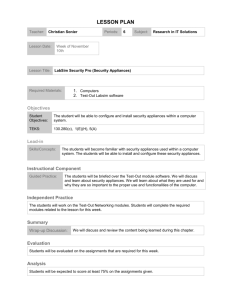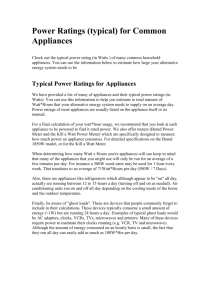Agenda Item 8: Update on Dual Appliances
advertisement

Agenda Item 8 TO: Policy and Finance Committee FROM: Director of Operational Support DATE: 28 November 2006 UPDATE ON DUAL APPLIANCES 1. Purpose 1.1 The purpose of this paper is to update the Policy and Finance Committee on the work undertaken thus far to investigate the dual appliance market and the potential for the use of one or more of these appliances in Cambridgeshire. It also recommends the way forward from this point to potential procurement. 2. Recommendations 2.1 The Policy and Finance Committee is asked to: a) note the work undertaken to date; b) endorse the continuation of the investigative work; and c) authorise the Chief Fire Officer, in consultation with the Chairman of the Fire Authority, to enter into such contracts as necessary to secure the use of a dual appliance. 3. Risk Assessment 3.1 Economic Dual appliances represent a significant capital cost to the Authority. However, with an expected life of 10 years they represent good value for money. Due to the fact that they are a fairly recent innovation, the true cost of maintenance over the life of the appliance is not known. However, it is believed that the cost of maintenance will be broadly similar to that of the current turntable ladder. It is possible that the provision of a dual appliance may lead to a further review of crewing at Cambridge and Peterborough, although it is probable that the outcome would be neutral in terms of overall establishment. 3.2 Social Where dual appliances have been introduced in other parts of the country, they have carried out more rescues from fire than existing aerial appliances. This aspect will improve the quality of service to the community and thereby reduce the number of injuries and death as a result of fire. 1 Agenda Item 8 3.3 Legal The Working at Height Regulations 2005 require employers to remove or reduce the risks to employees incurred by working at height. Whilst the Fire and Rescue Service cannot entirely eliminate the risks associated with working at height, dual appliances provide a safer method of working at height than traditional ladders. It should be noted that FiReBuy have expressed concern with regard to some contractual arrangements associated with the Magirus Multistar, however, it is possible that negotiation may be able to resolve any potential issues. 3.4 Political The FBU put forward a complex argument to the Corporate Planning and Finance Panel on 5 December 2005 regarding the move to alternate crewing turntable ladders and rescue vehicles. In response to the FBU submission, the Service advised the Panel on 22 December 2005 that it would “….. continue to assess the operational risks to firefighters who may need to work at height and seek to implement suitable and sufficient control measures…” The provision of a dual appliance would ensure the early provision of a safe working platform for firefighters and allay the unwarranted, but persistent, fears concerning the provision of an aerial rescue capability. 4. Background 4.1 During the first round of IRMP’s, many fire authorities looked to secure significant cost efficiencies in order to repay transitional funding provided by central Government by Year 3. The cost of providing a primary dedicated crewing system for turntable ladders was estimated to be £622k per annum. 4.2 The move to alternate crewing turntable ladders with rescue vehicles was subject to an in depth analysis and the proposal was published for public consultation in IRMP 2004/05. The proposal was subsequently adopted by the Fire Authority and implemented in 2004/05. 4.3 The Service remained aware of the need to consider alternative methods of addressing firefighter safety needs when working at height and started reviewing the use of dual appliances at the beginning of 2006. 5. Progress 5.1 An analysis of the market place has identified that there are two appliances that meet the needs of the Service. These are: 5.2 Magirus Multistar John Dennis/Vema A small working group comprising the Head of Community Risk Management Group, Head of Fleet and Equipment Services Group, two CFRS turntable 2 Agenda Item 8 ladder instructors, a FBU health and safety representative and a member of the Fire Authority have been involved in the evaluation of the dual appliance. 5.3 The mode of operation and range of functions is very similar on both appliances. Both appliances offer comparable high reach (30m) and operating envelopes similar to, or better than, the existing turntable ladders. 5.4 Both utilise extending booms as the method of operation. Both also provide remote control of all functions, which is a distinct advantage over the existing turntable ladders. 5.5 It should be noted that these appliances, whilst being able to replicate the functionality of traditional aerial appliances, will primarily be used as pumping appliances attending a normal range of operational incidents. 5.6 The working group proposes that one or both of the existing turntable ladders are retained for use in parts of the Fire Authority area where the provision of dual appliances is not justified. This would have the advantage of preventing dual appliances being committed for long periods away from their risk related station. 5.7 The Service considers that if the existing turntable ladders are retained, they should be crewed by specialist retained crews dedicated to that task. The cost of providing a retained crew would amount to £30k per annum. 5.8 Due to the number of services currently reducing the number of turntable ladders, it is considered that the sale of these items would not make economic sense. 5.9 Although both vehicles would meet the needs of this Authority, the Director of Operational Support has reviewed the development paths of both and considers the John Dennis/Vema to have been the most thoroughly researched and, importantly, to have benefited from the greatest amount of user input. Strathclyde will purchase 18 of these appliances and several other brigades have placed orders. Hence there is far greater confidence in the market with regard to the John Dennis/Vema appliance. Its growing presence in the market should allow this Authority, if it so desires, to purchase in the knowledge that sufficient volume has been sold to make further development and technological refresh of the product viable for the manufacturer. Given the involvement of Strathclyde throughout the development of the John Dennis/Vema appliance and their willingness to share their knowledge and experience, it is not considered necessary to expend further resources seeking assurances already provided to Strathclyde. 6. Financial Implications 6.1 The crewing of dual appliances differs within the brigades operating this equipment. The existing optimum ridership of a pumping appliance is five. However, Strathclyde are recommending a crew of six for the dual appliance. In order to provide two appliances, this leads to a potential increase of eight 3 Agenda Item 8 firefighters, at a cost to the Authority of £200k. The Service is currently identifying whether better management and use of existing resources can secure this resource. It is also probable that a further improvement of the rescue capabilities of front line pumping appliances may provide further opportunity to review the provision of rescue vehicles within Cambridgeshire. It is highly probable that establishment will, in the longer term, remain broadly the same making any changes cost neutral. 6.2 The capital cost of each appliance is circa £475k, which compares well with the cost of turntable ladders. However, the appliance would also reduce the requirement on the pumping appliance replacement programme. It is not intended that dual appliances would be subject to the cascade arrangements currently operated by the Service. The entire working life would be completed at Parkside and Stanground fire stations. 6.3 Because there is no potential to cascade these appliances to other stations across the Service, there are opportunities to consider different types of appliances for other locations based on risk, particularly in the retained stations. This is considered essential if the retained service is to improve its contribution to fire cover across Cambridgeshire and Peterborough. 7. Summary 7.1 The Service has undertaken a review of the market for dual appliances and identified that the Magirus Multistar and John Dennis/Vema appliances meet the needs of Cambridgeshire Fire and Rescue Service. These appliances should be seen as providing an enhanced rescue capability where they are stationed with a turntable ladder retaining its existing role to provide additional cover and resilience. 7.2 There is a potential revenue cost to the Authority resulting from increased crewing requirements. However, better shift management and further improvements to the rescue capability of front line pumping appliances may offset this. In the medium term it is assumed that full time establishment will remain at existing levels. 7.3 The Service has investigated the market for dual appliances and reviewed the vehicles meeting our perceived needs. The next phase of the project is to secure the loan of a chassis to check accessibility in key risk areas of the Authority’s area and commence the process of procurement. It is proposed to inform the Policy and Finance Committee at its next meeting of any decision to procure. 4 Agenda Item 8 BIBLIOGRAPHY Source Documents Location Contact Officer IRMP 2004/05 Hinchingbrooke Cottage Brampton Road Huntingdon Pete Ludford 01480 444556 FBU Submission Hinchingbrooke Cottage 05/12/05 to Brampton Road Corporate Planning & Huntingdon Finance Panel Graham Stagg 01480 444551 Pete.ludford@cambsfire.gov.uk Graham.Stagg@cambsfire.gov.uk Michael Brown 01480 444 472 Michael.Brown@cambsfire.gov.uk CFRS Response Hinchingbrooke Cottage 22/12/05 to Brampton Road Corporate Planning & Huntingdon Finance Panel Graham Stagg 01480 444551 Graham.Stagg@cambsfire.gov.uk Michael Brown 01480 444 472 Michael.Brown@cambsfire.gov.uk 5




